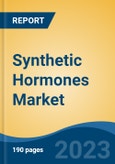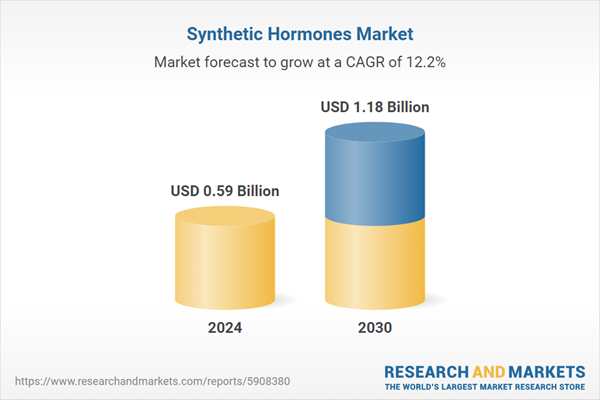Free Webex Call
The Synthetic Hormones Market was valued at USD 0.59 Billion in 2024, and is expected to reach USD 1.18 Billion by 2030, rising at a CAGR of 12.15%. Synthetic hormones are laboratory-manufactured versions of naturally occurring hormones in the human body. These hormones mimic the chemical structure and functions of those produced by the endocrine glands but are produced externally rather than within the body. Synthetic hormones serve various medical purposes, including hormone replacement therapy (HRT), contraception, and the treatment of hormone-related conditions. Speak directly to the analyst to clarify any post sales queries you may have.
10% Free customizationThis report comes with 10% free customization, enabling you to add data that meets your specific business needs.
They are prescribed by healthcare providers to address hormonal imbalances, manage symptoms of hormone-related disorders, and provide contraception. Synthetic hormones are commonly used in the treatment of conditions such as menopause symptoms, hypothyroidism, hormone-related cancers, and fertility control. These hormones are also integral to contraceptive methods such as birth control pills, patches, injections, and intrauterine devices (IUDs). They function by inhibiting ovulation, thickening cervical mucus, and altering the uterine lining to prevent the implantation of a fertilized egg.
The aging global population, especially in developed countries, continues to contribute to the demand for synthetic hormone therapies.
Key Market Drivers
Increasing Prevalence of Hormonal Disorders
The growing incidence of hormonal disorders is a major driver for the expansion of the global synthetic hormones market. Hormonal imbalances can affect various physiological functions, leading to chronic diseases, reproductive health issues, metabolic disorders, and growth abnormalities. Approximately 60 to 80 million couples globally face infertility challenges, driving the demand for hormone-based treatments and assisted reproductive technologies. In addition, developing nations often experience significant gaps in access to contraception, creating new opportunities for expanded family planning solutions. The lack of safe reproductive healthcare results in 115,000 to 204,000 deaths annually due to unsafe abortion practices, underscoring the urgent need for enhanced healthcare infrastructure and investment in reproductive health services.As the number of patients diagnosed with hormonal disorders rises, the demand for synthetic hormone therapies has increased. Conditions such as hypothyroidism, adrenal insufficiency, and menopause-related complications require long-term hormone replacement therapy (HRT). Synthetic hormones such as levothyroxine (for thyroid disorders), estrogen and progesterone (for menopause), and corticosteroids (for adrenal gland deficiencies) are essential in managing these conditions. The global population of postmenopausal women is expanding, with women aged 50 and older comprising 26% of the global female population in 2021, up from 22% a decade earlier. This demographic shift, coupled with increasing life expectancy, has led to greater demand for HRT, menopause management, and age-related healthcare innovations.
Diabetes, especially Type 1 diabetes, is another major hormonal disorder, impacting over 425 million people worldwide. With an expected increase in diabetes cases, the demand for synthetic insulin therapies is growing, which is a key segment within the synthetic hormones market. Pharmaceutical companies are investing in advanced insulin formulations and delivery systems, such as long-acting insulin analogs and smart insulin pens, to meet the demand for these therapies. Additionally, infertility due to lifestyle changes, stress, delayed pregnancies, and environmental factors has increased the need for assisted reproductive technologies (ART). Synthetic hormones such as gonadotropins, progesterone, and estrogen are essential in ART procedures like in-vitro fertilization (IVF) and ovulation induction therapies.
Key Market Challenges
Competition from Bioidentical Hormones
Bioidentical hormones, often perceived as more "natural" and less likely to cause adverse effects, present a growing competition to traditional synthetic hormones. Some consumers and healthcare providers prefer bioidentical hormones due to their customization and perceived safety benefits. Bioidentical hormones are often marketed aggressively, highlighting their advantages over synthetic hormones. Additionally, bioidentical hormones may be compounded individually by pharmacies to meet patients' specific needs, further increasing their appeal.However, bioidentical hormones face different regulatory scrutiny than synthetic hormones and are sometimes classified as dietary supplements rather than pharmaceuticals, potentially leading to variations in quality and safety standards. Despite the ongoing debate about their safety and efficacy, bioidentical hormones may lack the extensive clinical data supporting synthetic hormones. Moreover, their compounded nature can result in variations in formulation and dosage, complicating the establishment of consistent treatment protocols.
Insurance coverage for bioidentical hormones is often less common than for synthetic hormones, which can result in higher out-of-pocket costs for patients.
Key Market Trends
Focus on Personalized Medicine
A key trend in the Global Synthetic Hormones Market is the growing emphasis on personalized medicine. Personalized medicine enables healthcare providers to tailor hormone therapy and dosages based on individual patients' hormonal imbalances, genetics, and responses to treatment. This approach aims to deliver more effective and efficient treatment outcomes, reducing adverse reactions and improving patient safety and compliance. By considering individual factors such as genetic predisposition and response to treatment, personalized medicine helps minimize unnecessary interventions and optimize hormone therapy.In the treatment of conditions such as menopause or hypogonadism, personalized medicine allows for customized hormone replacement therapy (HRT) that targets the unique needs of each patient, ensuring better symptom relief and hormonal balance. Genetic testing can identify individuals at higher risk for hormone-related disorders or cancers, allowing for early intervention and prevention. Continuous patient monitoring allows for real-time adjustments to treatment plans, improving therapeutic outcomes. Additionally, personalized medicine can guide treatment decisions for hormone-related cancers, such as breast and prostate cancer, by identifying patients most likely to benefit from specific synthetic hormone therapies.
Key Market Players
- Acerus Pharmaceuticals Corp.
- American Regent, Inc.
- Anhui Anke Biotechnology (Group) Co. Ltd.
- BioPartners, Inc.
- Eli Lilly and Company
- Endo Pharmaceuticals, Inc.
- F. Hoffmann-La Roche Ltd.
- IBSA Institut Biochimique SA
- Lupin Pharmaceuticals, Inc.
- Pfizer, Inc.
Report Scope
This report segments the Global Synthetic Hormones Market into the following categories, in addition to detailing the industry trends:
Synthetic Hormones Market, by Product:
- Amino Acid Derivatives
- Peptide Hormones
- Steroid Hormones
Synthetic Hormones Market, by Route of Administration:
- Intravenous
- Nasal
- Oral
- Suppository
- Topical
Synthetic Hormones Market, by Application:
- Growth Hormone Deficiency
- Male Hypogonadism
- Menopause
- Thyroid Hormone Deficiency
Synthetic Hormones Market, by End-User:
- Hospital Pharmacies
- Online Pharmacies
- Retail Pharmacies
Synthetic Hormones Market, by Region:
- North America (United States, Canada, Mexico)
- Asia-Pacific (China, India, South Korea, Australia, Japan)
- Europe (Germany, France, United Kingdom, Spain, Italy)
- South America (Brazil, Argentina, Colombia)
- Middle East & Africa (South Africa, Saudi Arabia, UAE)
Competitive Landscape
The report provides detailed company profiles of the major players in the Global Synthetic Hormones Market.Available Customizations:
This Global Synthetic Hormones Market report offers customizations to meet specific company needs. The following options are available:
Company Information:
Detailed analysis and profiling of additional market players (up to five).This product will be delivered within 1-3 business days.
Table of Contents
1. Product Overview
2. Research Methodology
3. Executive Summary
5. Synthetic Hormones Market Outlook
6. North America Synthetic Hormones Market Outlook
7. Europe Synthetic Hormones Market Outlook
8. Asia-Pacific Synthetic Hormones Market Outlook
9. South America Synthetic Hormones Market Outlook
10. Middle East and Africa Synthetic Hormones Market Outlook
11. Market Dynamics
12. Market Trends & Developments
14. Competitive Landscape
Companies Mentioned
- Acerus Pharmaceuticals Corp.
- American Regent, Inc.
- Anhui Anke Biotechnology (Group) Co. Ltd.
- BioPartners, Inc
- Eli Lilly and Company
- Endo Pharmaceuticals, Inc.
- F. Hoffmann-La Roche Ltd.
- IBSA Institut Biochimique SA
- Lupin Pharmaceuticals, Inc.
- Pfizer, Inc
Table Information
| Report Attribute | Details |
|---|---|
| No. of Pages | 185 |
| Published | February 2025 |
| Forecast Period | 2024 - 2030 |
| Estimated Market Value ( USD | $ 0.59 Billion |
| Forecasted Market Value ( USD | $ 1.18 Billion |
| Compound Annual Growth Rate | 12.1% |
| Regions Covered | Global |
| No. of Companies Mentioned | 10 |









